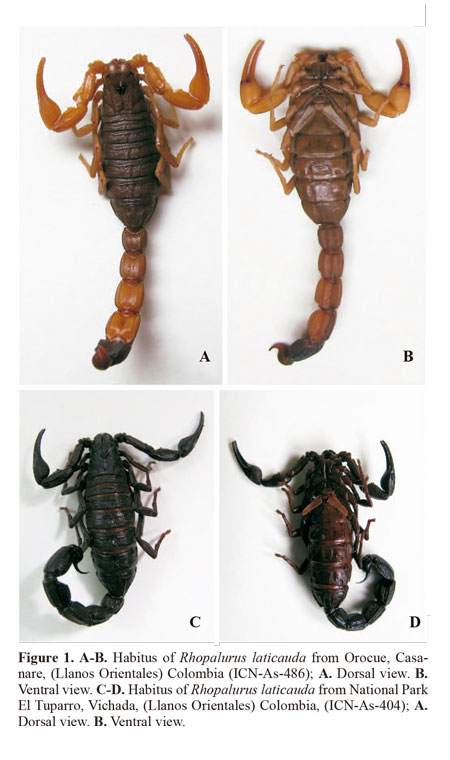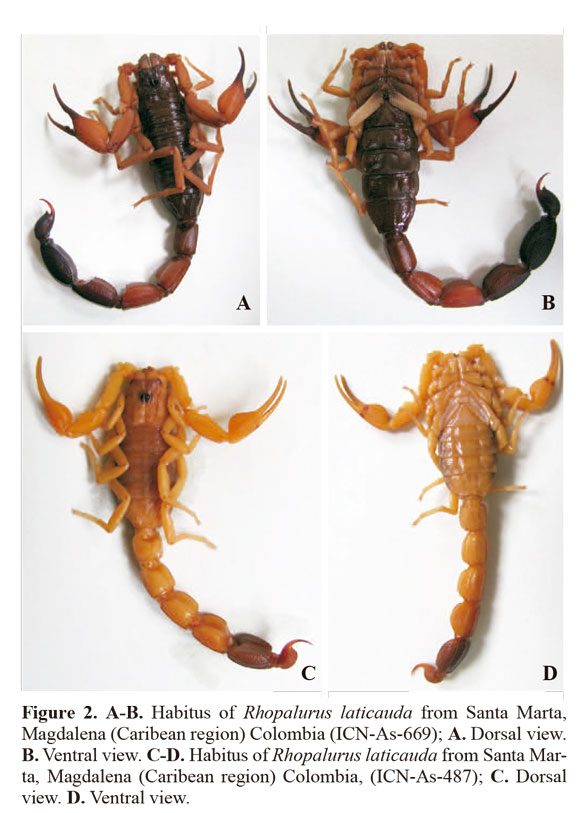Servicios Personalizados
Revista
Articulo
Indicadores
-
 Citado por SciELO
Citado por SciELO -
 Accesos
Accesos
Links relacionados
-
 Citado por Google
Citado por Google -
 Similares en
SciELO
Similares en
SciELO -
 Similares en Google
Similares en Google
Compartir
Revista Colombiana de Entomología
versión impresa ISSN 0120-0488
Rev. Colomb. Entomol. vol.38 no.2 Bogotá jul./dic. 2012
Rhopalurus caribensis, is a synonym of Rhopalurus laticauda (Scorpiones, Buthidae)
Rophalurus caribensis, es un sinónimo de Rophalurus laticauda (Scorpiones, Buthidae)
EDUARDO FLÓREZ D.1
1 M. Sc. Profesor Instituto de Ciencias Naturales, Universidad Nacional de Colombia, Apartado aéreo 7495, Bogotá, D.C., Colombia, aeflorezd@unal.edu.co
Received: 7-Feb-2012 - Accepted: 20-Nov-2012
Abstract: Rhopalurus caribensis Teruel & Roncallo, 2008 (n. syn.) is synonymized with R. laticauda Thorell, 1876, based on a review of morphological variations of characters listed by Roncallo and Teruel (2008). The biogeographic assumption presented by Teruel & Roncallo (2008) as an argument to justify the description of R. caribensis is refuted.
Key words: Synonymy. Taxonomy. Colombia.
Resumen: Rhopalurus caribensis Teruel & Roncallo, 2008 (n. sin.) es sinonimizado con R. laticauda Thorell, 1876, con base en la revisión de las variaciones morfológicas de los caracteres citados por Teruel & Roncallo (2008). Se refutan las hipótesis biogeográficas presentadas por Teruel & Roncallo (2008) como argumentos para justificar la descripción de R. caribensis son refutadas.
Palabras clave: Sinonimia. Taxonomía. Colombia.
Introduction
Rhopalurus laticauda Thorell, 1876 the type species of the genus, is distributed in open areas of savannas and lowlands of northern South America between Venezuela and Colombia. R. laticauda has been considered to be a polymorphic species due to coloration and size variations (Lourenço 1991; Manzanilla & Souza 2003).
Rhopalurus caribensis Teruel & Roncallo, 2008 was described on material from northern Colombia (Caribbean Region). The description was justified on the basis of morphological differences and a biogeographic rationale. The main arguments for the recognition of R. caribensis as a new species were: pattern of coloration, sculpturation, and differences in the number of pectinal teeth, which were whiter, smaller, less sculpturation and fewer pectinal tooth than specimens from the eastern Savannas (“Llanos Orientales”) of Colombia. These differences, in conjunction with the fact that the new species was allopatric with populations of R. laticauda, (at that time considered a single taxon), led the authors to conclude that a new species R. caribensis should be recognized for populations of northern Colombia.
The specimens studied are deposited in the Arachnological Collection of the Instituto de Ciencias Naturales of the Universidad Nacional de Colombia, Bogotá (ICN-MHN). The material represented 12 specimens from the Caribbean Region (seven females, one male and four juveniles) and four specimens from the Eastern Savannas (three females and one male), allowed us to preliminarily evaluate the diagnostic characters used by Teruel and Roncallo (2008) for the circumscription of R. caribensis.
Table 1 and figures 1-2 presents data that shows variations and characters overlaps occur with respect to the characters listed by Teruel & Roncallo for both regions. The coloration, sculpturation and size characters vary both in specimens from different localities from of the eastern Savannas and among sympatric specimens from Santa Marta (Caribbean region), while number of pectinal tooth, although are more homogeneous than Teruel and Roncallo (2008) specimens and Botero-Trujillo and Fagua (2007), show overlap between the two regions, reaching the highest numbers in specimens from Caribbean region, it is in contradiction to what was observed and postulated by Teruel and Roncallo (2008).
On the other hand, the biogeographic argument outlined on the Roncallo and Teruel (2008) paper is a misconception of Kattan et al. (2004) study, since they consider a supposed biota separation between Caribbean region and Eastern Savannas correspond to subregions called in Kattan et al. (2004) as “Perijá-Sierra Nevada de Santa Marta” and the “eastern slope of the Andes”, respectively. They overlooked the fact that Kattan et al. (2004) biogeographical analysis focused exclusively on the recognition of biogeographic patterns of the Andean regions (mountain) in Colombia, therefore not included the lowlands where are located the Eastern Savannas and the Caribbean region. The map 1 presented in Kattan et al. (2004), illustrates a precise biogeographical demarcation reported.
The information presented is congruent with by Lourenço (1993), Flórez (2001), and Botero-Trujillo and Fagua (2007), considering these disjoint populations as belonging to the same species, and therefore synonimize R. caribensis under R. laticauda.
Material examined
COLOMBIA. 1♀, Atlántico, Salgar, 400 m. 25-feb-2002, G. Amat leg [ICN-AS-440]. 1 juvenile, Magdalena, PN Tayrona, Neguanje, 155 m. 6-sep-1996, C. Valderrama leg [ICN-AS-430]. 4♀, 3 juveniles, Magdalena, Santa Marta, 2 m. 17-sep-2002. G.J. Parra leg [ICN-AS-487]; 2♀, Mismos datos, Taganga. 1 m. 15-oct-2002. G. J. Parra leg [ICN-AS-488]; 1♂, Mismos datos, Sierra Nevada de Santa Marta, Hacienda La Victoria, sector Jabalí. 1100 m. 29-abr-2006. J. C. Aguirre leg [ICN-AS-669]. 1♂, Arauca, La Conquista, Finca Macanguaro, 12 0m. s.f., F. Ortiz, leg [ICN-AS-105]. 1♀, Meta, Angostura, Parque Nacional La Macarena, s.a., ene-1997. J. O. Lemke, leg [ICN-AS-192]. 1♀, Casanare, Orocue. San Pablo, 130 m. 7-mar-1979. M. Barreto leg [ICN-AS-486]. 1♀, Vichada, PN El Tuparro, El Tapón. s.a. abr-1980. T. Defler, leg [ICN-AS-404].
Literature cited
BOTERO-TRUJILLO, R.; FAGUA, G. 2007. Additions to the knowledge of the geographical distribution of some Colombian scorpions (Buthidae: Ananteris, Rhopalurus, Tityus). Revista Ibérica de Aracnología 14: 129-134. [ Links ]
FLÓREZ, D. E. 2001. Escorpiones de la familia Buthidae (Chelicerata, Scorpiones) de Colombia. Biota Colombiana 2(1):25-30. [ Links ]
KATTAN, G. H.; PADU, F.; ROJAS, V.; MORALES, G. 2004. Biological diversification in a complex region: a spatial analysis of faunistic diversity and biogeography of the Andes of Colombia. Journal of Biogeography 31: 1829-1839. [ Links ]
LOURENÇO, W. R. 1991. Les scorpions de Colombie, II. Les faunes des regions de Santa Marta et de la Cordillera Orientale. Approche biogéographique, (Chelicerata: Scorpiones. Senckenbergiana Biologica 71 (4-6): 275-288. [ Links ]
LOURENÇO, W. R. 1993. Opisthacanthus lepturus (P. de Beauvois), scorpion modéle complexe de distribution. Biogeographica 69 (2): 87-88. [ Links ]
MANZANILLA, J.; SOUZA, DE, L. 2003. Ecología y distribución de Rhoplaurus laticauda Thorell, 1876 (Scorpiones, Buthidae) en Venezuela. Saber 15 (1-2): 3-14. [ Links ]
TERUEL, R.; RONCALLO, C. A. 2008. Rare or poorly known scorpions from Colombia. III. On the taxonomy and distribution of Rhoplaurus laticauda (Scorpiones, Buthidae) with description of a new species of the genus. Euscorpius 68: 1-12. [ Links ]















